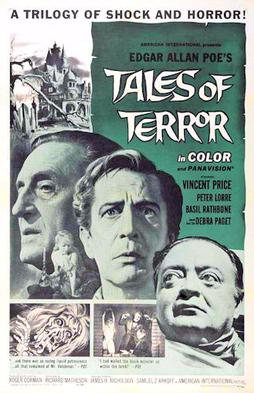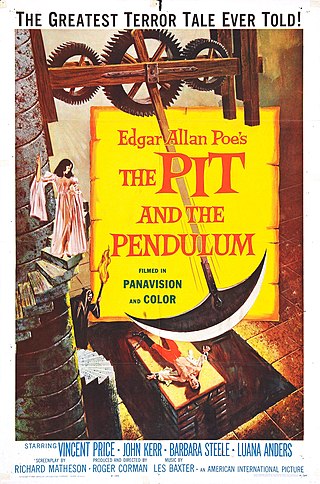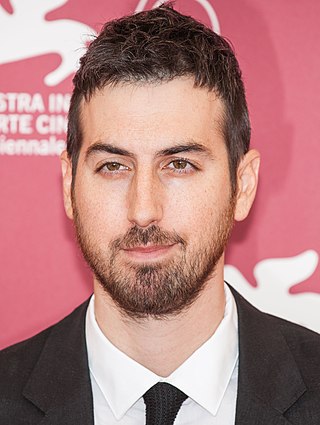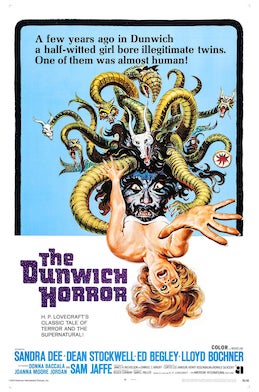Related Research Articles

Roger William Corman was an American film director, producer and actor. Known under various monikers such as "The Pope of Pop Cinema", "The Spiritual Godfather of the New Hollywood", and "The King of Cult", he was known as a trailblazer in the world of independent film.
American International Pictures LLC is an American film production company owned by Amazon MGM Studios. In its original operating period, AIP was an independent film production and distribution company known for producing and releasing films from 1955 until 1980, a year after its acquisition by Filmways in 1979.

The Last House on the Left is a 1972 rape and revenge film written and directed by Wes Craven in his directorial debut, and produced by Sean S. Cunningham. The film stars Sandra Peabody, Lucy Grantham, David Hess, Fred J. Lincoln, Jeramie Rain, and Marc Sheffler. Additionally, Martin Kove appears in a supporting role. The plot follows Mari Collingwood (Peabody), a teenager who is abducted, raped, and tortured by a family of violent fugitives led by Krug Stillo (Hess) on her seventeenth birthday. When her parents discover what happened to her, they seek vengeance against the family, who have taken shelter at their home.

Scary Movie 2 is a 2001 American supernatural parody film directed by Keenen Ivory Wayans. It is the sequel to Scary Movie and the second film in the Scary Movie film series. The film stars Anna Faris, Regina Hall, Shawn Wayans and Marlon Wayans, as well as Tim Curry, Tori Spelling, Chris Elliott, Chris Masterson, Kathleen Robertson, David Cross and James Woods. The film is the last in the series to feature the involvement of stars Marlon and Shawn Wayans, and director Keenan. Marlon would eventually go on to produce a similar horror-themed parody, A Haunted House, and its sequel, both starring himself. In the latter film, Wayans pokes fun at the Scary Movie series' decline in quality after his family's departure.

The Undead is a 1957 horror film directed by Roger Corman and starring Pamela Duncan, Allison Hayes, Richard Garland and Val Dufour. It also features Corman regulars Richard Devon, Dick Miller, Mel Welles and Bruno VeSota. The authors' original working title was The Trance of Diana Love. The film follows the story of a prostitute, Diana Love (Duncan), who is put into a hypnotic trance by psychic Quintus (Dufour), thus causing her to regress to a previous life. Hayes later starred in Attack of the 50 Foot Woman (1958). The film was released on February 14, 1957 by American International Pictures as a double feature with Voodoo Woman.

Tales of Terror is a 1962 American International Pictures Gothic horror anthology film in colour and Panavision, produced by Samuel Z. Arkoff, James H. Nicholson, and Roger Corman, who also directed. The screenplay was written by Richard Matheson, and the film stars Vincent Price, Peter Lorre, and Basil Rathbone. It is the fourth in the so-called Corman-Poe cycle of eight films, largely featuring adaptations of Edgar Allan Poe stories and directed by Corman for AIP. The film was released in 1962 as a double feature with Panic in Year Zero!.

Dementia 13, known in the United Kingdom as The Haunted and the Hunted, is a 1963 independently made black-and-white horror-thriller film produced by Roger Corman, and written and directed by Francis Ford Coppola in his feature film directorial debut. The film stars William Campbell and Luana Anders with Bart Patton, Mary Mitchell, and Patrick Magee. It was released in the United States by American International Pictures during the fall of 1963 as the bottom half of a double feature with Corman's X: The Man with the X-ray Eyes.

The Pit and the Pendulum is a 1961 horror film directed by Roger Corman, starring Vincent Price, Barbara Steele, John Kerr, and Luana Anders. The screenplay by Richard Matheson was loosely inspired by Edgar Allan Poe's 1842 short story of the same name. Set in sixteenth-century Spain, the story is about a young Englishman who visits a foreboding castle to investigate his sister's mysterious death. After a series of horrific revelations, apparently ghostly appearances and violent deaths, the young man becomes strapped to the titular torture device by his lunatic brother-in-law during the film's climactic sequence.

Saturday the 14th is a 1981 American comedy horror film starring real-life husband and wife Paula Prentiss and Richard Benjamin, co-written and directed by Howard R. Cohen and produced by Julie Corman.

Timon C. West is an American film director, producer, screenwriter, editor, cinematographer, and occasional actor, best known for his work in horror films. He directed the horror films The Roost (2005), Trigger Man (2007), The House of the Devil (2009), The Innkeepers (2011), the Western In a Valley of Violence (2016) as well as the X film series. He has also acted in a number of films, mostly in those directed by either himself or Joe Swanberg.

The Big Doll House is a 1971 American women-in-prison film starring Pam Grier, Judy Brown, Roberta Collins, Brooke Mills, and Pat Woodell. The film follows six female inmates through daily life in a gritty, unidentified tropical prison. Later the same year, the film Women in Cages featured a similar story and setting and much the same cast, and was shot in the same abandoned prison buildings. A nonsequel follow-up, titled The Big Bird Cage, was released in 1972.

The Nightcomers is a 1971 British horror film directed by Michael Winner and starring Marlon Brando, Stephanie Beacham, Thora Hird, Harry Andrews and Anna Palk. It is a prequel to Henry James' 1898 novella The Turn of the Screw, which had already been adapted into The Innocents (1961).

The Premature Burial, also known as Premature Burial, is a 1962 American horror film directed by Roger Corman and starring Ray Milland, Hazel Court, Alan Napier, Heather Angel and Richard Ney. The screenplay by Charles Beaumont and Ray Russell is based upon the 1844 short story of the same name by Edgar Allan Poe. It was the third in the series of eight Poe-themed pictures, known informally as the "Poe Cycle", directed by Corman for American International Pictures.

The Dunwich Horror is a 1970 American supernatural horror film directed by Daniel Haller, and starring Sandra Dee, Dean Stockwell, and Ed Begley. A loose adaptation of the short story of the same name by H. P. Lovecraft, the film concerns a young female graduate student who is targeted by a man attempting to use her in an occult ritual taken from the Necronomicon. The screenplay was co-written by Curtis Hanson, while Roger Corman served as an executive producer on the film.

Full Circle, released in the United States as The Haunting of Julia, is a 1977 supernatural horror film directed by Richard Loncraine, and starring Mia Farrow and Keir Dullea. Based on the novel Julia by the American writer Peter Straub, it is the first film realization of one of his books, and follows a woman who, after the death of her daughter, finds herself haunted by the vengeful ghost of a young girl in her new home.

Naked Paradise is a 1957 drama film directed by Roger Corman. It stars Richard Denning and Beverly Garland.

The Twilight People is a 1972 Filipino-American horror film directed by Eddie Romero. It was produced by Romero and John Ashley, and written by Romero and Jerome Small. It stars Ashley and features, in an early film appearance, Pam Grier in a supporting role.
Concorde Anois was a short lived film production company based in Ireland that operated in the late 1990s. It was an offshoot of Roger Corman's Concorde Pictures. Anois is the Irish language word for 'now'.

The Haunting of Bly Manor is an American gothic romance supernatural horror drama television miniseries created by Mike Flanagan, and released on October 9, 2020 by Netflix. The second entry in Flanagan's The Haunting anthology series, it mostly acts as an adaptation of the 1898 novella The Turn of the Screw by Henry James, but also includes other elements either based on James' other works or created for the show. It features much of Hill House's crew and some of the same cast, such as Victoria Pedretti, Oliver Jackson-Cohen, Amelia Eve, T'Nia Miller, Rahul Kohli, Tahirah Sharif, Amelie Bea Smith, Benjamin Evan Ainsworth, and Henry Thomas. Although Pedretti, Jackson-Cohen and Thomas returned from Hill House as different characters, as did Kate Siegel, Carla Gugino, and Catherine Parker in recurring roles, the two series' narratives are not connected.
The Lockdown Hauntings is a 2021 British horror film written and directed by Howard J. Ford and starring Tony Todd and Angela Dixon.
References
- ↑ The Haunting of Hell House at IMDb
- ↑ The Haunting of Hell House at the TCM Movie Database
- 1 2 3 Merlin's horror movie: [Final 1 Edition] Dalby, Douglas. Sunday Times; London (UK) [London (UK)]09 Oct 2005: 5.
- ↑ ATTACK OF THE LOW-BUDGET HORROR FILMS: [All Editions: Four Star B, Three Star B, Two Star P, One Star B] DOUG NYE, Special from Knight Ridder Newspapers. The Record 29 Oct 1999: Y01.
- ↑ Kelly, Brendan (1999-08-30). "Review: 'Henry James' the Ghostly Rental'". Variety . Retrieved 2014-02-20.